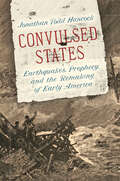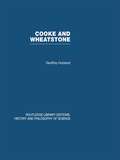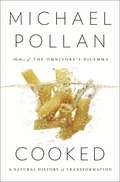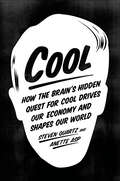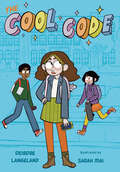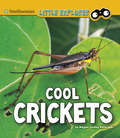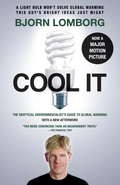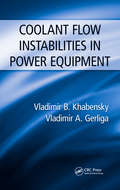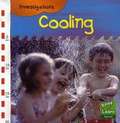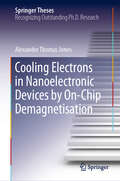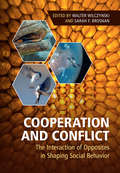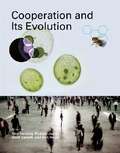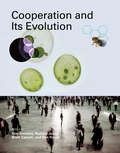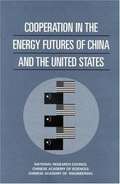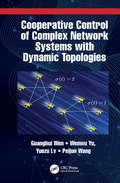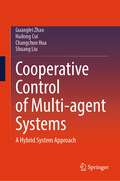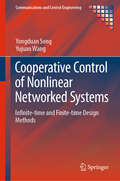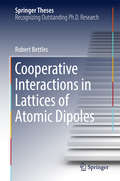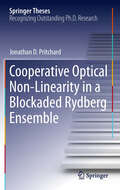- Table View
- List View
Conveyor Belt Furnace Thermal Processing
by Ken Kuang Jinlong Xu Joyce ZhangThis practical book is tailored for engineers working in the industry, and condenses more than a decade's worth of application experience on furnaces. The various topics discussed include conveyor furnaces, belt furnaces, solar cells, brazing furnaces, thick film furnaces, and furnace air flow and reflow. There are chapters on the influence of belt furnace and firing on silicon solar cells, thin film CIGS solar cells, dye-sensitized solar cells, crystalline solar cells, and lithium ion batteries, as well as how the processes affect the efficiency of each. The authors also address the influence of belt furnace on various processes such as metallization, engine valve heat treatment, brazing, post mold curing, and glass-to-metal sealing. The last few chapters also address Direct Bond Copper (DBC) technologies, and the effect of profile and atmosphere on the reflow process.
Convictions Without Truth: The Incompatibility of Science and Law (Routledge Frontiers of Criminal Justice)
by Robert SchehrConvictions Without Truth sets out to determine whether and to what extent science and law may coexist in an institutional relationship that truthfully generates individualization through application of forensic testimony for charges relating to violations of criminal law. In the first two chapters, readers are exposed to contemporary unscientific forensic practices as juxtaposed to the evidentiary standard announced by the United States Supreme Court in Daubert v. Merrill Dow Pharmaceuticals, as well as scientific requirements for validity and reliability of expert witness testimony. The remaining chapters provide an explanation for retention of existing, though faulty, forensic practices by way of analysis of path dependency, the fixation of belief, and neuro and cognitive psychology. Through immanent critique and unmasking, the book deconstructs prevailing forensic practices through application of existing published documentation. The final chapter addresses the fixation of belief from the perspective of neuropsychology and cognitive psychology. Readers will gain an understanding of the current concerns relating to application of contemporary forensic practices ; current case law and federal rules guiding the introduction of expert witness testimony; and why it is that despite widely recognized concerns raised from within and outside of the criminal legal system, application of unscientific forensic practices continues., The book also shows how the criminal legal system is experiencing a paradigm shift due to dialectical juxtaposition of existing unscientific forensic practices with contemporary science. Readers are shown that because of its continued reliance upon unscientific forensic practices, the criminal legal system reveals its hegemonic commitment to social control through its willingness to accept "satisfying" as opposed to "truthful" results that generate wrongful convictions. Convictions Without Truth will be of particular interest to students, academics, and practitioners working within the criminal legal field. It will also appeal to those wanting to know more about forensics and criminal law.
Convolutional Neural Networks for Medical Image Processing Applications
by Şaban ÖztürkThe rise in living standards increases the expectation of people in almost every field. At the forefront is health. Over the past few centuries, there have been major developments in healthcare. Medical device technology and developments in artificial intelligence (AI) are among the most important ones. The improving technology and our ability to harness the technology effectively by means such as AI have led to unprecedented advances, resulting in early diagnosis of diseases. AI algorithms enable the fast and early evaluation of images from medical devices to maximize the benefits. While developments in the field of AI were quickly adapted to the field of health, in some cases this contributed to the formation of innovative artificial intelligence algorithms. Today, the most effective artificial intelligence method is accepted as deep learning. Convolutional neural network (CNN) architectures are deep learning algorithms used for image processing. This book contains applications of CNN methods. The content is quite extensive, including the application of different CNN methods to various medical image processing problems. Readers will be able to analyze the effects of CNN methods presented in the book in medical applications.
Convulsed States: Earthquakes, Prophecy, and the Remaking of Early America
by Jonathan Todd HancockThe New Madrid earthquakes of 1811–12 were the strongest temblors in the North American interior in at least the past five centuries. From the Great Plains to the Atlantic Coast and from the Great Lakes to the Gulf of Mexico, a broad cast of thinkers struggled to explain these seemingly unprecedented natural phenomena. They summoned a range of traditions of inquiry into the natural world and drew connections among signs of environmental, spiritual, and political disorder on the cusp of the War of 1812. Drawn from extensive archival research, Convulsed States probes their interpretations to offer insights into revivalism, nation remaking, and the relationship between religious and political authority across Native nations and the United States in the early nineteenth century. With a compelling narrative and rigorous comparative analysis, Jonathan Todd Hancock uses the earthquakes to bridge historical fields and shed new light on this pivotal era of nation remaking. Through varied peoples' efforts to come to grips with the New Madrid earthquakes, Hancock reframes early nineteenth-century North America as a site where all of its inhabitants wrestled with fundamental human questions amid prophecies, political reinventions, and war.
Cooke and Wheatstone: And the Invention of the Electric Telegraph (Routledge Library Editions: History & Philosophy of Science)
by Geoffrey HubbardOriginally published in 1965. Charles Wheatstone collaborated with William Cooke in the invention and early exploitation of the Electric Telegraph. This was the first long distance, faster-than-a-horse messenger. This volume gives an account of the earlier work on which the English invention was founded, and the curious route by which it came to England. It discusses the way in which two such antagonistic men were driven into collaboration and sets out the history of the early telegraph lines, including work on the London and Birmingham Railway and the Great Western Railway.
Cooked: A Natural History of Transformation
by Michael PollanIn Cooked, Michael Pollan explores the previously uncharted territory of his own kitchen, discovering the enduring power of the four classical elements -- fire, water, air, and earth -- to transform the stuff of nature into delicious things to eat and drink.
Cool: How the Brain's Hidden Quest for Cool Drives Our Economy and Shapes Our World
by Steven Quartz Anette Asp“This engrossing history merges evolutionary biology and economics to explain our spending habits” and show how coolness is at the heart of consumerism (Mental Floss).We live in a world of conspicuous consumption, where the things we buy not only satisfy our needs, but also communicate our values, identities, and aspirations. In Cool, Steven Quartz and Anette Asp bring together groundbreaking findings in neuroscience, economics, and evolutionary biology to show how our concepts of “cool”—be it designer jeans, smartphones, or craft beer—help drive the global economy.Cool puts forth a provocative theory of consumerism based on our brain’s innate status-seeking and “social calculator”. The authors highlight the underlying processes that guide our often-unconscious decision making. They also pull back the curtain on “choice architects” who design store interiors, as well as “coolhunters” who scour Berlin and Tokyo for the latest trends.Quartz and Asp follow the evolution of “cool consumption” from the mid-twentieth century through the emergence of the Internet in the 1990s, finally unpacking the social motivations behind today’s hip, ethical consumption. Taking us from Norman Mailer to normcore, Cool is surprising at every turn, and will forever change the way you think about money, status, and your next purchase.
The Cool Code (The Cool Code #1)
by Deirdre LangelandIn this funny and heartfelt slice-of-life graphic novel for fans of Raina Telgemeier and Kayla Miller, when coding whiz Zoey goes from homeschooled to new school, she develops an app to help her make friends. Will the Cool Code help Zoey fit in? Or will it completely crash her social life?In an attempt to fit in, Zoey develops an app called the Cool Code with a cute llama avatar that will tell her everything from what to say to what to wear based on pop culture algorithms she’s uploaded.But when the app gives her ridiculous advice, awkwardness and hilarity ensues. With a few upgrades and a bit of debugging from the coding club, the app actually works—Zoey gets really popular . . . and gets her pulled in all kinds of directions, including away from her real friends.Life’s most complicated choices. . . is there a code for that?
Cool Crickets (Little Entomologist 4D)
by Megan Cooley PetersonChirping fills the night air, and you know crickets must be nearby! But did you also know that each species has its own unique song? Or that these tiny jumpers have ears on their legs? Meet cool crickets from around the world with Smithsonian Little Entomologist. Kids will be wowed by the amazing variety of bugs and up-close photos, while also learning about bug behavior, life cycle, diet, and more. The engaging, leveled text supports life science curriculum.
Cool It: The Skeptical Environmentalist's Guide to Global Warming
by Bjørn LomborgGlobal warming has become one of the permanent concerns of our time, with ever stronger calls to combat it via drastic programs, like the Kyoto Protocol. In this highly controversial book, Bjorn Lomborg (author of the bestselling The Skeptical Environmentalist) claims that the arguments for such action are little more than scare mongering and exposes this wide range of disinformation. Global warming is happening. It's a serious and important problem and we need to deal with it in a responsible way. B...
Coolant Flow Instabilities in Power Equipment
by Vladimir B. Khabensky Vladimir Antonovich GerligaThermal-hydraulic instability can potentially impair thermal reliability of reactor cores or other power equipment components. Thus it is important to address stability issues in power equipment associated with thermal and nuclear installations, particularly in thermal nuclear power plants, chemical and petroleum industries, space technology, and r
The Cooling
by Lowell PonteAre we entering a new ice age? Many scientists think so. Many others say that the climate is becoming unstable, and that this instability is a critical threat to world food production. Earth's climate has been cooling rapidly for the past three decades, and this has already caused drought and famine in major areas of the world. In the time it takes you to read this book, at least a thousand people will have starved to death because of the impact climatic instability already has had on food production. And The Cooling has barely begun. Few questions are as urgent today as those concerning climate change and what may be done about it. Dr. Cesare Emiliani, a "paleoclimatologist" at the University of Miami, says: "Is Earth's climate changing? Should governments try to modify climate? In dealing with these controversial issues, Lowell Ponte has written a remarkably thorough, far-ranging, balanced, and scientifically accurate book-the best popular book I have read on both these questions. I recommend THE COOLING to anyone who likes to think, and who cares about the planet we share."
Cooling
by Patricia WhitehousePart of the Read and Learn collection, the books in the Investigations series explore the forces and motions involved in familiar activities and include experiments for children to try out.
Cooling Electrons in Nanoelectronic Devices by On-Chip Demagnetisation (Springer Theses)
by Alexander Thomas JonesThis thesis demonstrates that an ultralow temperature refrigeration technique called "demagnetisation refrigeration" can be miniaturised and incorporated onto millimeter-sized chips to cool nanoelectronic circuits, devices and materials. Until recently, the lowest temperature ever reached in such systems was around 4 millikelvin. Here, a temperature of 1.2mK is reported in a nanoelectronic device. The thesis introduces the idea that on-chip demagnetization refrigeration can be used to cool a wide variety of nanostructures and devices to microkelvin temperatures. This brings the exciting possibility of discovering new physics, such as exotic electronic phases, in an unexplored regime and the potential to improve the performance of existing applications, including solid-state quantum technologies. Since the first demonstration of on-chip demagnetization refrigeration, described here, the technique has been taken up by other research groups around the world. The lowest on-chip temperature is currently 0.4mK. Work is now underway to adapt the technique to cool other materials and devices, ultimately leading to a platform to study nanoscale materials, devices and circuits at microkelvin temperatures.
Cooperation and Collective Action: Archaeological Perspectives
by David M. CarballoPast archaeological literature on cooperation theory has emphasized competition's role in cultural evolution. As a result, bottom-up possibilities for group cooperation have been under theorized in favor of models stressing top-down leadership, while evidence from a range of disciplines has demonstrated humans to effectively sustain cooperative undertakings through a number of social norms and institutions. Cooperation and Collective Action is the first volume to focus on the use of archaeological evidence to understand cooperation and collective action. Disentangling the motivations and institutions that foster group cooperation among competitive individuals remains one of the few great conundrums within evolutionary theory. The breadth and material focus of archaeology provide a much needed complement to existing research on cooperation and collective action, which thus far has relied largely on game-theoretic modeling, surveys of college students from affluent countries, brief ethnographic experiments, and limited historic cases. In Cooperation and Collective Action, diverse case studies address the evolution of the emergence of norms, institutions, and symbols of complex societies through the last 10,000 years. This book is an important contribution to the literature on cooperation in human societies that will appeal to archaeologists and other scholars interested in cooperation research.
Cooperation and Conflict: The Interaction of Opposites in Shaping Social Behavior
by Walter Wilczynski Sarah F. BrosnanUnderstanding the interaction between cooperation and conflict in establishing effective social behaviour is a fundamental challenge facing societies. Reflecting the breadth of current research in this area, this volume brings together experts from biology to political science to examine the cooperation–conflict interface at multiple levels, from genes to human societies. Exploring both the exciting new directions and the biggest challenges in their fields, the authors focus on identifying commonalities across species and disciplines to help understand what features are shared broadly and what are limited to specific contexts. Each chapter is written to be accessible to students and researchers from interdisciplinary backgrounds, with text boxes explaining terminology and concepts that may not be familiar across disciplinary boundaries, while being a valuable resource to experts in their fields.
Cooperation and Its Evolution
by Kim Sterelny Brett Calcott Ben Fraser Richard JoyceThis collection reports on the latest research on an increasingly pivotal issue for evolutionary biology: cooperation. The chapters are written from a variety of disciplinary perspectives and utilize research tools that range from empirical survey to conceptual modeling, reflecting the rich diversity of work in the field. They explore a wide taxonomic range, concentrating on bacteria, social insects, and, especially, humans. Part I ("Agents and Environments") investigates the connections of social cooperation in social organizations to the conditions that make cooperation profitable and stable, focusing on the interactions of agent, population, and environment. Part II ("Agents and Mechanisms") focuses on how proximate mechanisms emerge and operate in the evolutionary process and how they shape evolutionary trajectories. Throughout the book, certain themes emerge that demonstrate the ubiquity of questions regarding cooperation in evolutionary biology: the generation and division of the profits of cooperation; transitions in individuality; levels of selection, from gene to organism; and the "human cooperation explosion" that makes our own social behavior particularly puzzling from an evolutionary perspective.
Cooperation and Its Evolution (Life and Mind: Philosophical Issues in Biology and Psychology)
by Kim Sterelny Richard Joyce Brett Calcott Ben FraserEssays from a range of disciplinary perspectives show the central role that cooperation plays in structuring our world.This collection reports on the latest research on an increasingly pivotal issue for evolutionary biology: cooperation. The chapters are written from a variety of disciplinary perspectives and utilize research tools that range from empirical survey to conceptual modeling, reflecting the rich diversity of work in the field. They explore a wide taxonomic range, concentrating on bacteria, social insects, and, especially, humans.Part I ("Agents and Environments") investigates the connections of social cooperation in social organizations to the conditions that make cooperation profitable and stable, focusing on the interactions of agent, population, and environment. Part II ("Agents and Mechanisms") focuses on how proximate mechanisms emerge and operate in the evolutionary process and how they shape evolutionary trajectories. Throughout the book, certain themes emerge that demonstrate the ubiquity of questions regarding cooperation in evolutionary biology: the generation and division of the profits of cooperation; transitions in individuality; levels of selection, from gene to organism; and the "human cooperation explosion" that makes our own social behavior particularly puzzling from an evolutionary perspective.
Cooperation In The Energy Futures Of China And The United States
by Chinese Academy of Science Staff Chinese Academy of Engineering Staff National Research Council StaffToday we recognize the importance of the pending transition in energy resource utilization in the coming century. Two major players in this transition will be two of the world's superpowers - - China and the United States. Cooperation in the Energy Futures of China and the United States focuses on collaborative opportunities to provide affordable, clean energy for economic growth and social development, to minimize future energy concerns, environmental threats to our global society, and the health and economic impacts on energy production and use.
Cooperative Breeding in Vertebrates
by Koenig, Walter D. den Ridder, Stef Walter D. Koenig Stef Den RidderCooperative breeders are species in which individuals beyond a pair assist in the production of young in a single brood or litter. Although relatively rare, cooperative breeding is widespread taxonomically and continues to pose challenges to our understanding of the evolution of cooperation and altruistic behavior. Bringing together long-term studies of cooperatively breeding birds, mammals, and fishes, this volume provides a synthesis of current studies in the field. The chapters are organised by individual studies of particular species or (in the case of mole-rats) two closely related cooperatively breeding species. Each focuses not only on describing behavior and ecology but also on testing evolutionary hypotheses for the form and function of the diverse and extraordinary cooperative breeding lifestyles that have been discovered. This unique and comprehensive text will be of interest to graduate students and researchers of behavioral ecology and the evolution of cooperation.
Cooperative Control of Complex Network Systems with Dynamic Topologies
by Guanghui Wen Wenwu Yu Yuezu Lv Peijun WangFar from being separate entities, many social and engineering systems can be considered as complex network systems (CNSs) associated with closely linked interactions with neighbouring entities such as the Internet and power grids. Roughly speaking, a CNS refers to a networking system consisting of lots of interactional individuals, exhibiting fascinating collective behaviour that cannot always be anticipated from the inherent properties of the individuals themselves. As one of the most fundamental examples of cooperative behaviour, consensus within CNSs (or the synchronization of complex networks) has gained considerable attention from various fields of research, including systems science, control theory and electrical engineering. This book mainly studies consensus of CNSs with dynamics topologies - unlike most existing books that have focused on consensus control and analysis for CNSs under a fixed topology. As most practical networks have limited communication ability, switching graphs can be used to characterize real-world communication topologies, leading to a wider range of practical applications. This book provides some novel multiple Lyapunov functions (MLFs), good candidates for analysing the consensus of CNSs with directed switching topologies, while each chapter provides detailed theoretical analyses according to the stability theory of switched systems. Moreover, numerical simulations are provided to validate the theoretical results. Both professional researchers and laypeople will benefit from this book.
Cooperative Control of Multi-agent Systems: A Hybrid System Approach
by Guanglei Zhao Hailong Cui Changchun Hua Shuang LiuThis book focuses on stability analysis and control design approaches for multi-agent systems under network-induced constraints. A hybrid system approach is introduced to address the cooperative control problem of networked multi-agent systems, and several important topics such as asynchronous sampled data cooperative control, hybrid event-triggered cooperative control, and reset-based cooperative control are studied under the hybrid system framework. The special feature of this book is that a hybrid systems approach is proposed for the cooperative control of multi-agent systems, which is beneficial for relaxing the conservativeness of stability analysis and network parameter computation. Interested readers can learn a novel approach to cooperative control of multi-agent systems, and this book can benefit researchers, engineers, and graduate students in the fields of multi-robot cooperation, unmanned aerial vehicle formation, control engineering, etc.
Cooperative Control of Nonlinear Networked Systems: Infinite-time and Finite-time Design Methods (Communications and Control Engineering)
by Yongduan Song Yujuan WangCooperative Control of Nonlinear Networked Systems is concerned with the distributed cooperative control of multiple networked nonlinear systems in the presence of unknown non-parametric uncertainties and non-vanishing disturbances under certain communication conditions. It covers stability analysis tools and distributed control methods for analyzing and synthesizing nonlinear networked systems. The book presents various solutions to cooperative control problems of multiple networked nonlinear systems on graphs. The book includes various examples with segments of MATLAB® codes for readers to verify, validate, and replicate the results. The authors present a series of new control results for nonlinear networked systems subject to both non-parametric and non-vanishing uncertainties, including the cooperative uniformly ultimately bounded (CUUB) result, finite-time stability result, and finite-time cooperative uniformly ultimately bounded (FT-CUUB) result. With some mathematical tools, such as algebraic graph theory and certain aspects of matrix analysis theory introduced by the authors, the readers can obtain a deeper understanding of the roles of matrix operators as mathematical machinery for cooperative control design for multi-agent systems. Cooperative Control of Nonlinear Networked Systems is a valuable source of information for researchers and engineers in cooperative adaptive control, as its technical contents are presented with examples in full analytical and numerical detail, and graphically illustrated for easy-to-understand results. Scientists in research institutes and academics in universities working on nonlinear systems, adaptive control and distributed control will find the book of interest, as it contains multi-disciplinary problems and covers different areas of research.
Cooperative Interactions in Lattices of Atomic Dipoles (Springer Theses)
by Robert BettlesThis thesis reports the remarkable discovery that, by arranging the dipoles in an ordered array with particular spacings, it is possible to greatly enhance the cross-section and achieve a strong light-matter coupling (>98% of the incident light). It also discusses the broad background to cooperative behaviour in atomic ensembles, and analyses in detail effects in one- and two-dimensional atomic arrays. In general, when light interacts with matter it excites electric dipoles and since the nineteenth century it has been known that if the amplitude of these induced dipoles is sufficiently large, and their distance apart is on the scale of the wavelength of the light, then their mutual interaction significantly modifies the light-matter interaction. However, it was not known how to exploit this effect to modify the light-matter interaction in a desirable way, for example in order to enhance the optical cross-section.
Cooperative Optical Non-Linearity in a Blockaded Rydberg Ensemble (Springer Theses)
by Jonathan D. PritchardThis thesis describes the first demonstration of a cooperative optical non-linearity based on Rydberg excitation. Whereas in conventional non-linear optics the non-linearity arises directly from the interaction between light and matter, in a cooperative process it is mediated by dipole-dipole interactions between light-induced excitations. For excitation to high Rydberg states where the electron is only weakly bound, the dipole-dipole interactions are extremely large and long range, enabling an enormous enhancement of the non-linear effect. Consequently, cooperative non-linear optics using Rydberg excitations opens a new era for quantum optics enabling large single photon non-linearity to be accessible in free space for the first time. The thesis describes the theoretical underpinnings of the non- linear effect, the pioneering experimental results and implications for experiments in the single photon regime.



